 Backend Development
Backend Development PHP Tutorial
PHP Tutorial How to deal with website protection and firewall in PHP development
How to deal with website protection and firewall in PHP development
Title: Website protection and firewall practice in PHP development
Introduction:
In today's Internet environment, website security issues are becoming increasingly prominent. As a commonly used server-side programming language, website protection and firewall measures in PHP development are particularly important. This article will introduce some commonly used PHP website protection technologies and firewall practices, and provide specific code examples for readers' reference.
1. Website protection technology:
- Input filtering: Effectively detect and filter user-entered data to avoid attacks such as malicious scripts or SQL injections. Input filtering can be easily implemented using PHP's filter functions, such as using filter_input, filter_var and other functions to verify and filter user input.
$username = filter_input(INPUT_POST, 'username', FILTER_SANITIZE_STRING);
- Password security: User passwords are an important part of website security. When storing passwords in the database, they should be encrypted using a hashing algorithm. PHP's password_hash function can generate the hash value of the password, and the password_verify function is used to verify whether the password entered by the user is correct.
$password = password_hash($password, PASSWORD_DEFAULT);
if (password_verify($inputPassword, $storedPassword)) {
// 验证通过
} else {
// 验证失败
}- Session management: Reasonably manage user session information to prevent attacks such as session hijacking or session fixation. PHP's session_start function starts a session and disables access to cookies through scripts by setting session.cookie_httponly to true.
session_start();
ini_set("session.cookie_httponly", 1);2. Firewall practice:
- IP filtering: perform access control based on specific IP addresses to prevent access from malicious IPs. Use PHP's $_SERVER['REMOTE_ADDR'] to obtain the visitor's IP address, and compare it with the preset blacklist to implement IP filtering.
$allowed_ips = array('127.0.0.1', '10.0.0.1');
$client_ip = $_SERVER['REMOTE_ADDR'];
if (!in_array($client_ip, $allowed_ips)) {
header('HTTP/1.0 403 Forbidden');
die('Access denied.');
}- Request limit: Limit the number of requests sent by a certain IP address within a specified time to prevent malicious interface brushing or DoS attacks. Use PHP's cache or database to store the timestamp and number of requests of the last request, compare them with the current time, and implement request restrictions.
$key = 'ip_' . $_SERVER['REMOTE_ADDR'];
$current_time = time();
$expire_time = 60; // 限制为每分钟只能发起一次请求
$limit = 5; // 限制为每分钟最多发起5次请求
$cache = new Redis();
$cache->connect('127.0.0.1', 6379);
if (!$cache->exists($key)) {
$cache->set($key, 1, $expire_time);
} else {
$cache->incr($key);
}
$count = $cache->get($key);
if ($count > $limit) {
header('HTTP/1.0 429 Too Many Requests');
die('Request limit exceeded.');
}Conclusion:
In PHP development, website protection and firewall are important measures to ensure website security. Through effective input filtering, password security, session management, and firewall practices, the risk of a website being attacked can be greatly reduced. In actual development, developers should choose an appropriate protection strategy based on the actual situation, and carry out appropriate optimization and enhancement.
The above is the detailed content of How to deal with website protection and firewall in PHP development. For more information, please follow other related articles on the PHP Chinese website!
 php CodeIgniter安全指南:保护你的网站免遭攻击Feb 19, 2024 pm 06:21 PM
php CodeIgniter安全指南:保护你的网站免遭攻击Feb 19, 2024 pm 06:21 PM1.使用最新版本的CodeIgniterCodeIgniter团队会定期发布安全补丁和更新来修复已知的漏洞。因此,确保你始终使用最新版本的CodeIgniter非常重要。你可以通过访问CodeIgniter的官方网站来下载最新版本。2.强制使用安全连接(HTTPS)https可以加密你的网站和用户之间传递的数据,使其更难被恶意用户截获和窃取。你可以通过在你的服务器上安装SSL证书来启用HttpS。3.避免使用默认配置CodeIgniter提供了许多默认配置来简化开发过程。但是,这些默认配置可能并
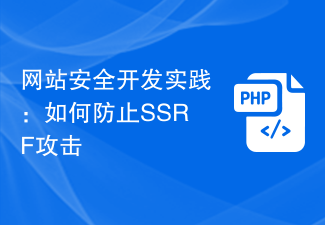 网站安全开发实践:如何防止SSRF攻击Jun 29, 2023 am 11:58 AM
网站安全开发实践:如何防止SSRF攻击Jun 29, 2023 am 11:58 AM网站安全开发实践:如何防止SSRF攻击随着互联网的迅速发展,越来越多的企业和个人选择将业务搬上云端,网站安全问题也日益引起人们的关注。其中一种常见的安全威胁是SSRF(Server-SideRequestForgery,服务端请求伪造)攻击。本文将介绍SSRF攻击的原理和危害,并提供一些常用的防范措施,帮助开发人员加固网站的安全性。SSRF攻击的原理和危
 网站安全开发实践:如何防止XML外部实体攻击(XXE)Jun 29, 2023 am 08:51 AM
网站安全开发实践:如何防止XML外部实体攻击(XXE)Jun 29, 2023 am 08:51 AM网站安全开发实践:如何防止XML外部实体攻击(XXE)随着互联网的发展,网站已经成为人们获取和共享信息的重要途径。然而,随之而来的风险也在不断增加。其中之一就是XML外部实体攻击(XXE),这是一种利用XML解析器漏洞的攻击方式。在这篇文章中,我们将介绍什么是XXE攻击以及如何防止它。一、什么是XML外部实体攻击(XXE)?XML外部实体攻击(XXE)是一种
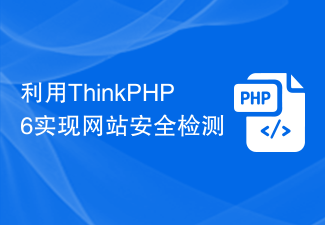 利用ThinkPHP6实现网站安全检测Jun 20, 2023 am 09:03 AM
利用ThinkPHP6实现网站安全检测Jun 20, 2023 am 09:03 AM随着互联网的不断发展,越来越多的网站涌现出来,但与此同时,网站的安全问题也愈发严重。黑客攻击、恶意软件、SQL注入等安全漏洞令网站运营商头疼不已。为了保证网站的安全性,网站建设和运营过程中的安全检测也显得尤为重要。本文将介绍如何利用ThinkPHP6实现网站安全检测,帮助网站运营者进一步提升网站安全性。一、什么是ThinkPHP6ThinkPHP6是一款PH
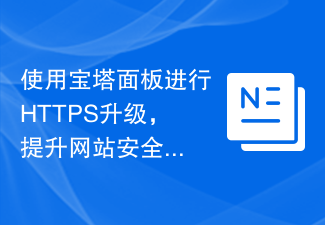 使用宝塔面板进行HTTPS升级,提升网站安全性Jun 21, 2023 am 10:15 AM
使用宝塔面板进行HTTPS升级,提升网站安全性Jun 21, 2023 am 10:15 AM随着互联网的发展,网站已成为企业展示形象和与外界交流的重要渠道。然而,随之而来的网络安全问题也确实令人担忧。许多网站管理者可能已经意识到通过使用HTTPS协议来保护用户数据和交易信息的重要性,但是对于如何实现HTTPS升级可能还不是非常了解。本文将介绍如何利用宝塔面板来进行HTTPS升级,提升网站的安全性。一、什么是HTTPS?HTTP是超文本传输协议,是一
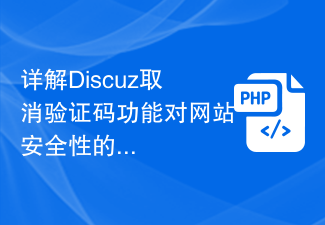 详解Discuz取消验证码功能对网站安全性的影响Mar 11, 2024 am 10:45 AM
详解Discuz取消验证码功能对网站安全性的影响Mar 11, 2024 am 10:45 AM《Discuz取消验证码功能对网站安全性的影响探讨》随着互联网的快速发展,网站安全问题日益凸显。验证码作为一种常见的安全验证机制,在网站中被广泛应用。然而,有些网站为了提高用户体验,可能会取消验证码功能,这是否会对网站安全性造成负面影响呢?本文将就Discuz取消验证码功能对网站安全性的影响进行探讨,并提供具体的代码示例。一、验证码的作用及原理验证码(CAP
 C++ 函数在网络编程中如何实现网络防火墙?Apr 26, 2024 pm 04:18 PM
C++ 函数在网络编程中如何实现网络防火墙?Apr 26, 2024 pm 04:18 PM使用C++函数可以轻松在网络编程中实现网络防火墙,具体步骤如下:编写检查数据包有效性的函数:验证源IP地址是否允许验证端口号是否允许验证数据包类型是否允许编写处理数据包的函数:允许有效数据包通过丢弃无效数据包创建防火墙对象并配置允许的IP地址、端口号和数据包类型监听网络流量并处理收到的数据包
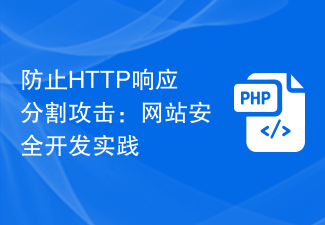 防止HTTP响应分割攻击:网站安全开发实践Jun 30, 2023 pm 12:45 PM
防止HTTP响应分割攻击:网站安全开发实践Jun 30, 2023 pm 12:45 PM网站安全一直是互联网领域的一个重要话题,随着网络技术的不断发展,黑客的攻击手段也变得越来越复杂和隐蔽。其中一种常见的攻击方式是HTTP响应分割攻击。本文将从原理和实践两个方面介绍如何有效地防止这种攻击,以保护网站的安全。首先,我们来了解一下HTTP响应分割攻击的原理。该攻击利用了HTTP协议中的一个漏洞,即在响应头和响应体之间插入换行符来分割响应,从而导致服


Hot AI Tools

Undresser.AI Undress
AI-powered app for creating realistic nude photos

AI Clothes Remover
Online AI tool for removing clothes from photos.

Undress AI Tool
Undress images for free

Clothoff.io
AI clothes remover

AI Hentai Generator
Generate AI Hentai for free.

Hot Article

Hot Tools

Dreamweaver CS6
Visual web development tools

DVWA
Damn Vulnerable Web App (DVWA) is a PHP/MySQL web application that is very vulnerable. Its main goals are to be an aid for security professionals to test their skills and tools in a legal environment, to help web developers better understand the process of securing web applications, and to help teachers/students teach/learn in a classroom environment Web application security. The goal of DVWA is to practice some of the most common web vulnerabilities through a simple and straightforward interface, with varying degrees of difficulty. Please note that this software

WebStorm Mac version
Useful JavaScript development tools

Atom editor mac version download
The most popular open source editor

MinGW - Minimalist GNU for Windows
This project is in the process of being migrated to osdn.net/projects/mingw, you can continue to follow us there. MinGW: A native Windows port of the GNU Compiler Collection (GCC), freely distributable import libraries and header files for building native Windows applications; includes extensions to the MSVC runtime to support C99 functionality. All MinGW software can run on 64-bit Windows platforms.





